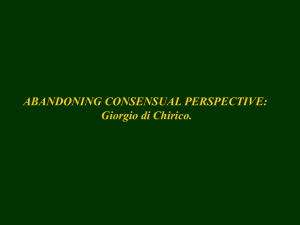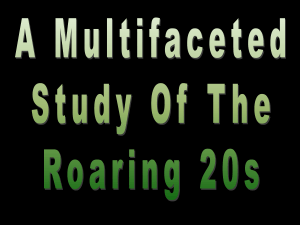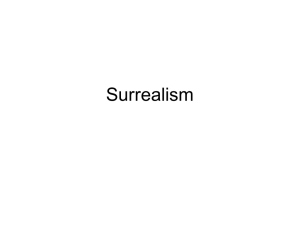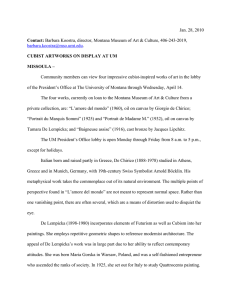deChirico
advertisement
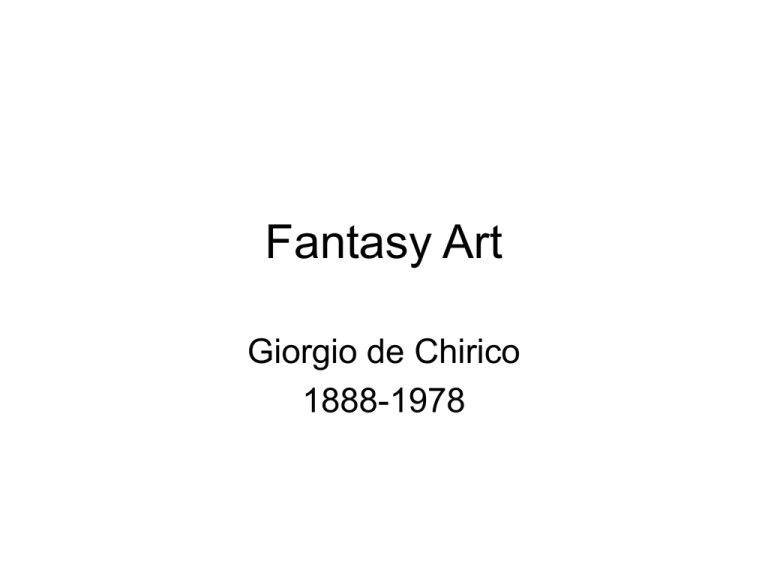
Fantasy Art Giorgio de Chirico 1888-1978 de Chirico • Major Italian painter, who founded the metaphysical school. He was born in Volos, Greece, the son of an Italian engineer. He studied art in Athens and in Munich, where he was strongly influenced by the allegorical works of the 19th-century Swiss painter Arnold Böcklin. de Chirico • From 1924 to 1930 de Chirico gave enormous impetus to the surrealist movement and influenced such surrealists as Yves Tanguy and Salvador Dalí. By the mid-1930s he had turned to an outworn academic style and chose to become a fashionable portraitist. de Chirico • As an army conscript in Ferrara in 1915 de Chirico met the futurist painter Carlo Carrà; together they founded the magazine Pittura Metafisica in 1920. From 1915 to 1925 de Chirico painted bizarre, faceless mannequins and juxtaposed wildly unrelated objects in his still lifes, a technique adopted by the surrealists. de Chirico • In Turin and Florence and in Paris, where he settled in 1911, he painted deserted cityscapes, such as Enigma of an Autumn Night (1910) and Mystery and Melancholy of a Street (1914). These early metaphysical works, through sharp contrasts of light and shadow and exaggerated perspective, evoke a haunting, ominous dream world. Melancholy and Mystery of a Street 1914 The Song of Love 1914 The Song of Love • The Song of Love (also known as Le chant d'amour or Love Song; 1914) is a painting by the Italian metaphysical painter Giorgio de Chirico. It is one of the most famous works by de Chirico and an early example of the surrealist style, though it was painted ten years before the movement was “founded” by André Breton in 1924. • It depicts an outdoor architectural setting similar to other works by de Chirico at this time. This time however, the main focus is a small wall on which is mounted a Greek sculpted head and a surgeons glove. Below it is a green ball. On the horizon is the outline of a locomotive, an image that recurs several times during this period of de Chirico’s career. Metaphysical Art • Metaphysical art (Italian: Pittura metafisica) is the name of an Italian art movement, created by Giorgio de Chirico and Carlo Carrà. Their dream-like paintings of squares typical of idealized Italian cities, as well as apparently casual juxtapositions of objects, represented a visionary world which engaged most immediately with the unconscious mind, beyond physical reality, hence the name. The metaphysical movement provided significant impetus for the development of Dada and Surrealism. de Chirico • Carrà had been among the leading painters of Futurism. De Chirico had been working in Paris, admired by Apollinaire and avant-garde artists as a painter of mysterious urban scenes and still lifes.The two painters already knew of each other and formed an immediate alliance, further encouraged by the poetry of Alberto Savinio, de Chirico's younger brother. Aside from De Chirico and Carrà, other painters associated with metaphysical art include Savinio, Giorgio Morandi and Filippo De Pisis. The Disquieting Muses 1916 The Disquieting Muses • The Disquieting Muses (in Italian: Le Muse inquietanti, 1916) is a painting by the Italian metaphysical painter Giorgio de Chirico. It is one of the most famous works of the Italian painter and of metaphysical art. • The painting was finished in 1916, during World War I, when De Chirico was in Ferrara. The city, considered by him the "perfect metaphysical city", offered several hints to his inspiration, including the Castello Estense which appears in the background of the painting. Other typical elements of De Chirico art of the time are present in the work: the dummies, the empty urban spaces, with a square covered by wooden plates to resemble a stage, a factory with high chimneys, all set within a timeless frame. • The Muses are "disquieting" for, in De Chirico's ideals, they had to path the way to overcome appearances and made the observers dialogue with unknown. This painting would later become the inspiration for Sylvia Plath's poem "The Disquieting Muses". Muses • The Muses (Ancient Greek) perhaps from the o-grade of the Proto-Indo-European root *men- "think") in Greek mythology, poetry, and literature are the goddesses or spirits who inspire the creation of literature and the arts. They were considered the source of the knowledge, related orally for centuries in the ancient culture, that was contained in poetic lyrics and myths. Originally said to be three in number, by the Classical times of the 400s BC, their number had grown and become set at nine goddesses who embody the arts and inspire the creation process with their graces through remembered and improvised song and stage, writing, traditional music, and dance. The Poet and His Muse 1922 Le Vaticinateur" (1915) “Metaphysical Interior with Biscuits” Hector et Andromache La Commedia e La Tragedia Artwork Evaluation Questions • • • • • • • • What do you think the artist was trying to say? How did the artist use the materials to express idea? Describe the cultural or historical influence in this work. What connections can you make to specific cultures? What does the artwork symbolize or represent? Discuss the expressive qualities of the artwork? Do you like or dislike the artwork---why? Do the elements of art play a significant role in the artwork? How and why? • What is the focal point of the artwork?---why do you think the artist was trying to emphasize this?
